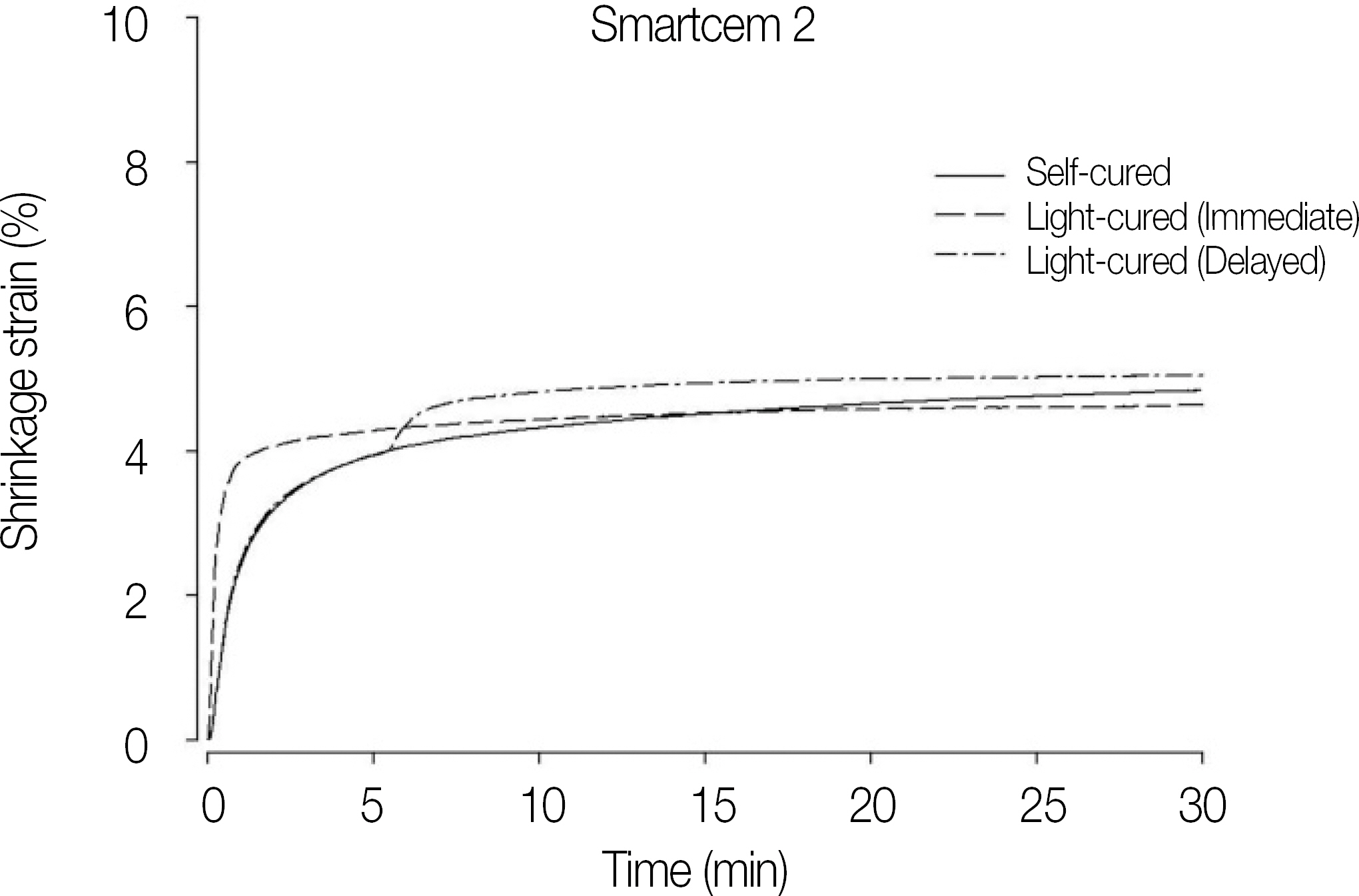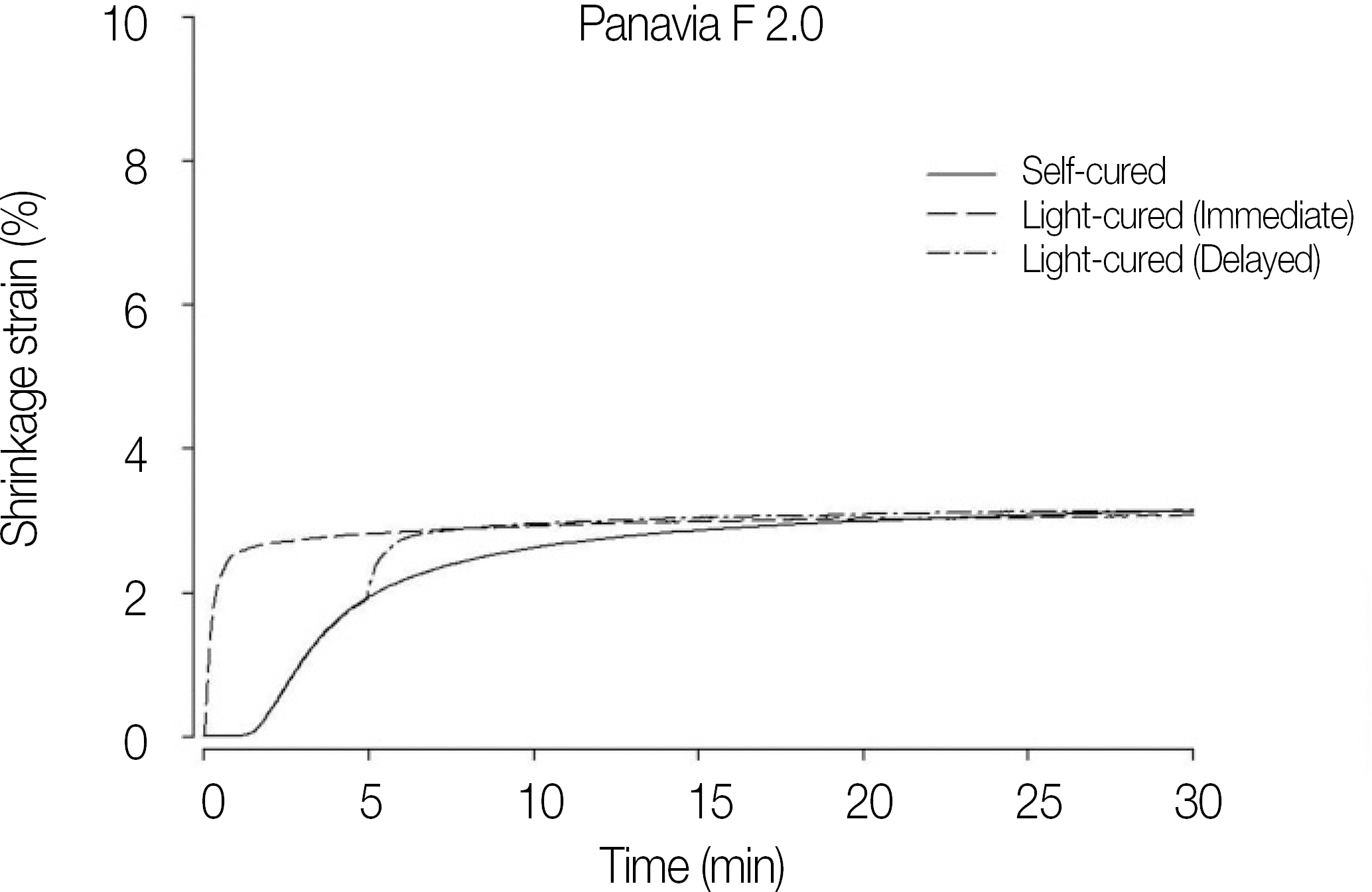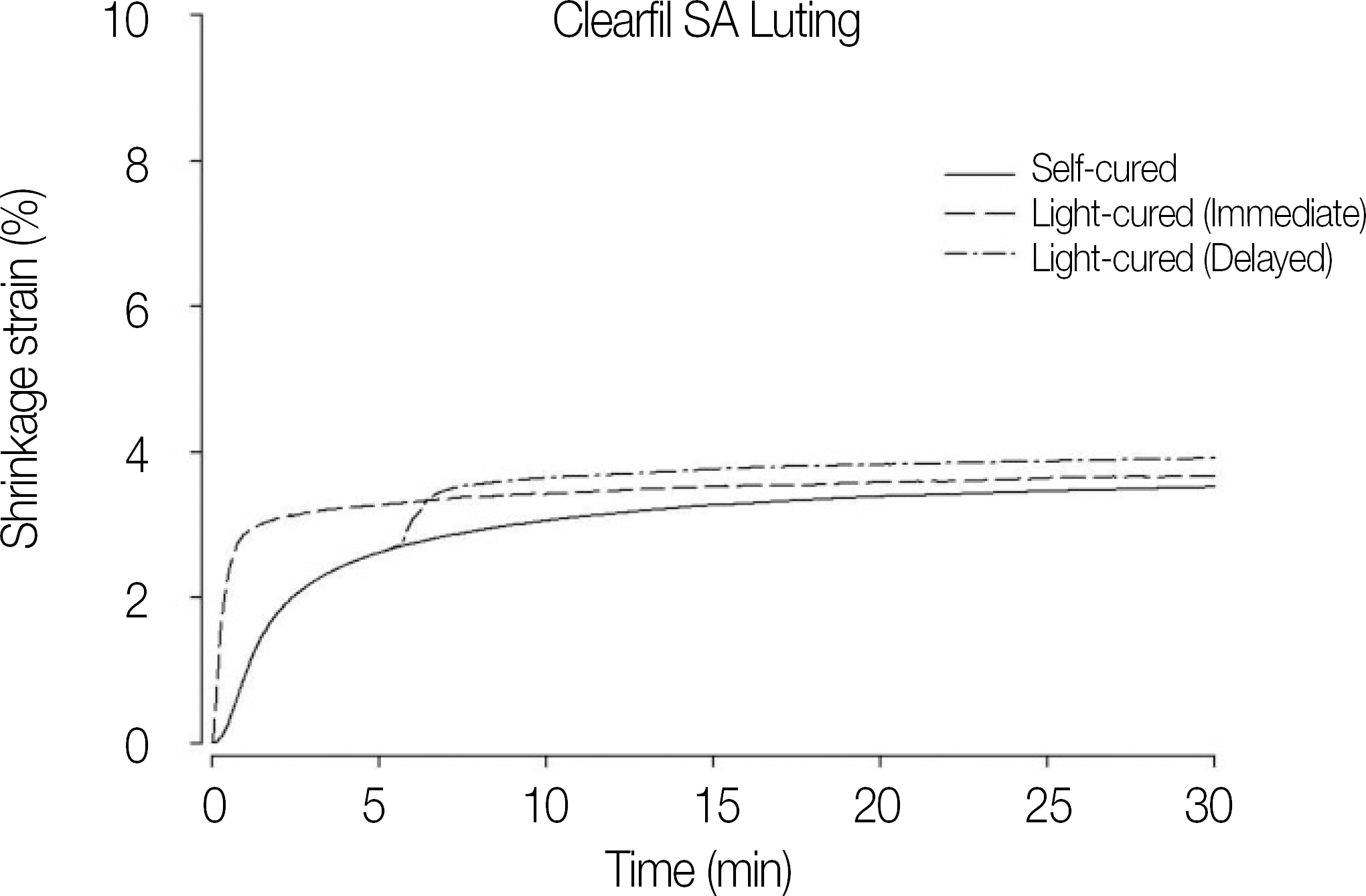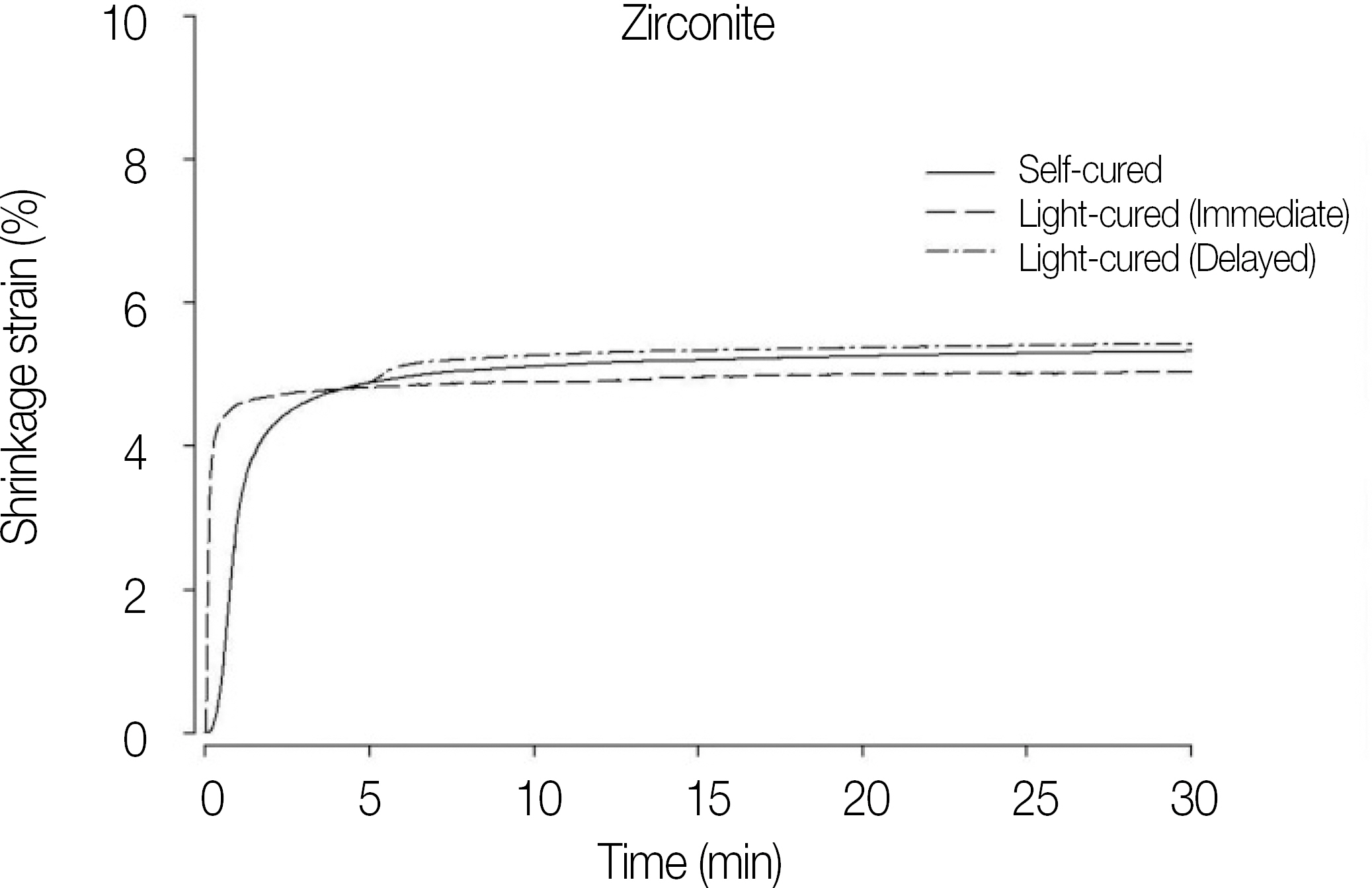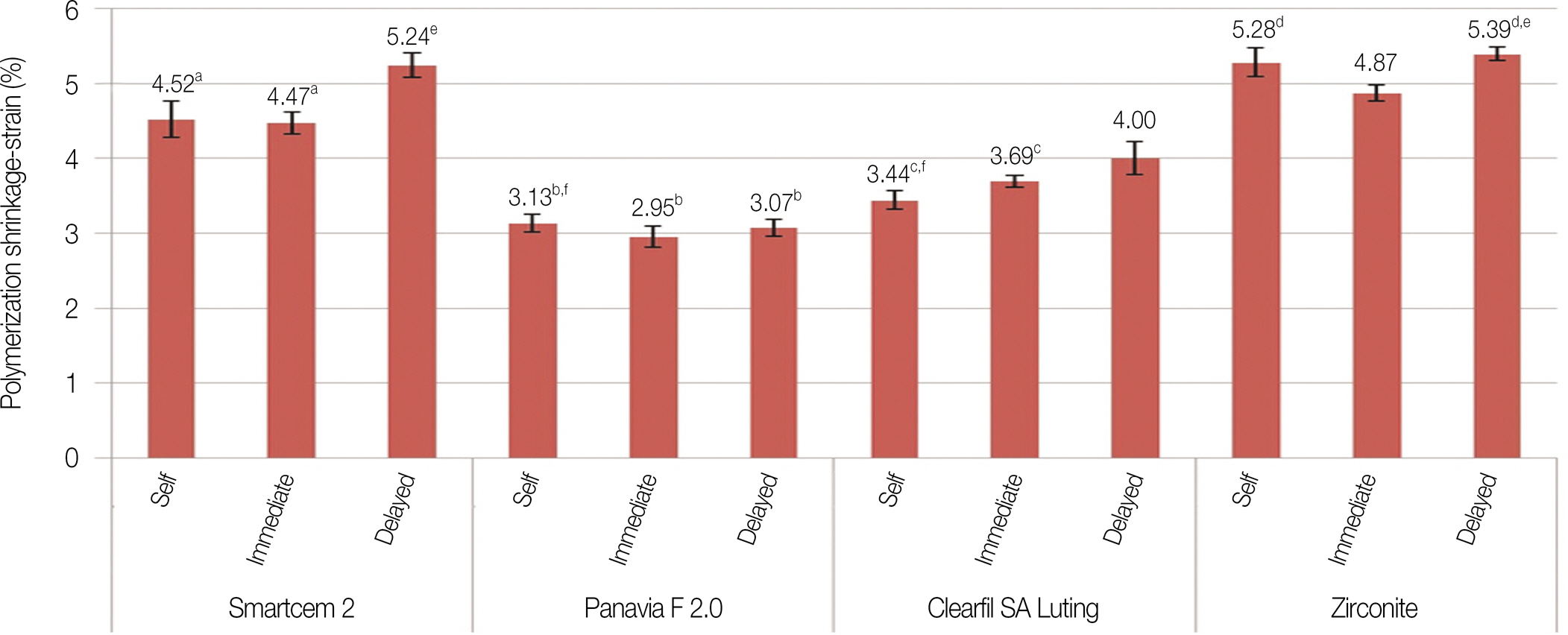J Korean Acad Prosthodont.
2014 Jul;52(3):195-201. 10.4047/jkap.2014.52.3.195.
Effects of immediate and delayed light activation on the polymerization shrinkage-strain of dual-cure resin cements
- Affiliations
-
- 1School of Dentistry, Seoul National University, Seoul, Republic of Korea.
- 2Department of Prosthodontics and Dental Research Institute, School of Dentistry, Seoul National University, Seoul, Republic of Korea. ksh1250@snu.ac.kr
- 3Department of Dentistry, School of Medicine, Ajou University, Suwon, Republic of Korea.
- 4Department of Prosthodontics, Dankook University Dental Clinic, Cheonan, Republic of Korea.
- 5Department of Prosthodontics, Veterans Health Service Medical Center Seoul, Republic of Korea.
- KMID: 2195425
- DOI: http://doi.org/10.4047/jkap.2014.52.3.195
Abstract
- PURPOSE
This study was designed to compare the amount of polymerization shrinkage of dual-cure resin cements according to different polymerization modes and to determine the effect of light activation on the degree of polymerization.
MATERIALS AND METHODS
Four kinds of dual-cure resin cements were investigated: Smartcem 2, Panavia F 2.0, Clearfil SA Luting and Zirconite. Each material was tested in three different polymerization modes: self-polymerization only, immediate light polymerization and 5 minutes-delayed light polymerization. The time-dependent polymerization shrinkage-strain was evaluated for 30 minutes by Bonded-disk method at 37degrees C. Five recordings of each material with three different modes were taken. Data were analyzed using one-way ANOVA and multiple comparison Scheffe'test (alpha=.05).
RESULTS
All materials, except Panavia F 2.0, exhibited the highest polymerization shrinkage-strain through delayed light-activated polymerization. No significant difference between light activation modes was found with Panavia F 2.0. All materials exhibited more than 90% of polymerization rate in the immediate or delayed light activated group within 10 minutes.
CONCLUSION
As a clinical implication of this study, the application of delayed light activation mode to dual-cure resin cements is advantageous in terms of degree of polymerization.
Figure
Reference
-
1. Venhoven BA, de Gee AJ, Davidson CL. Light initiation of dental resins: dynamics of the polymerization. Biomaterials. 1996; 17:2313–8.
Article2. Braga RR, Ferracane JL. Contraction stress related to degree of conversion and reaction kinetics. J Dent Res. 2002; 81:114–8.
Article3. Lu H, Stansbury JW, Bowman CN. Towards the elucidation of shrinkage stress development and relaxation in dental composites. Dent Mater. 2004; 20:979–86.
Article4. Calheiros FC, Daronch M, Rueggeberg FA, Braga RR. Influence of irradiant energy on degree of conversion, polymerization rate and shrinkage stress in an experimental resin composite system. Dent Mater. 2008; 24:1164–8.
Article5. Hansel C, Leyhausen G, Mai UE, Geurtsen W. Effects of various resin composite (co)monomers and extracts on two caries-associated micro-organisms in vitro. J Dent Res. 1998; 77:60–7.
Article6. Arikawa H, Kanie T, Fujii K, Shinohara N. Bending strength and depth of cure of light-cured composite resins irradiated using filters that simulate enamel. J Oral Rehabil. 2004; 31:74–80.
Article7. Di Francescantonio M, Aguiar TR, Arrais CA, Cavalcanti AN, Davanzo CU, Giannini M. Influence of viscosity and curing mode on degree of conversion of dual-cured resin cements. Eur J Dent. 2013; 7:81–5.8. de Menezes MJ, Arrais CA, Giannini M. Influence of light-activated and auto- and dual-polymerizing adhesive systems on bond strength of indirect composite resin to dentin. J Prosthet Dent. 2006; 96:115–21.
Article9. Arrais CA, Giannini M, Rueggeberg FA, Pashley DH. Microtensile bond strength of dual-polymerizing cementing systems to dentin using different polymerizing modes. J Prosthet Dent. 2007; 97:99–106.
Article10. Pegoraro TA, da Silva NR, Carvalho RM. Cements for use in esthetic dentistry. Dent Clin North Am. 2007; 51:453–71.
Article11. Atlas AM, Raman P, Dworak M, Mante F, Blatz MB. Effect of delayed light polymerization of a dual-cured composite base on microleakage of Class 2 posterior composite open-sandwich restorations. Quintessence Int. 2009; 40:471–7.12. Moraes RR, Faria-e-Silva AL, Ogliari FA, Correr-Sobrinho L, Demarco FF, Piva E. Impact of immediate and delayed light activation on self-polymerization of dual-cured dental resin luting agents. Acta Biomater. 2009; 5:2095–100.
Article13. Watts DC, Cash AJ. Determination of polymerization shrinkage kinetics in visible-light-cured materials: methods development. Dent Mater. 1991; 7:281–7.
Article14. Watts DC, Marouf AS. Optimal specimen geometry in bonded-disk shrinkage-strain measurements on light-cured biomaterials. Dent Mater. 2000; 16:447–51.
Article15. Kim SH, Watts DC. Polymerization shrinkage-strain kinetics of temporary crown and bridge materials. Dent Mater. 2004; 20:88–95.
Article16. Spinell T, Schedle A, Watts DC. Polymerization shrinkage kinetics of dimethacrylate resin-cements. Dent Mater. 2009; 25:1058–66.
Article17. Moraes RR, Brandt WC, Naves LZ, Correr-Sobrinho L, Piva E. Light- and time-dependent polymerization of dual-cured resin luting agent beneath ceramic. Acta Odontol Scand. 2008; 66:257–61.
Article18. Kim JW, Jang KT, Lee SH, Kim CC, Hahn SH, Garc l′ a-Godoy F. Effect of curing method and curing time on the microhardness and wear of pit and fissure sealants. Dent Mater. 2002; 18:120–7.
Article19. el-Mowafy OM, Rubo MH, el-Badrawy WA. Hardening of new resin cements cured through a ceramic inlay. Oper Dent. 1999; 24:38–44.20. Braga RR, Cesar PF, Gonzaga CC. Mechanical properties of resin cements with different activation modes. J Oral Rehabil. 2002; 29:257–62.
Article21. Blackman R, Barghi N, Duke E. Influence of ceramic thickness on the polymerization of light-cured resin cement. J Prosthet Dent. 1990; 63:295–300.
Article22. Arrais CA, Rueggeberg FA, Waller JL, de Goes MF, Giannini M. Effect of curing mode on the polymerization characteristics of dual-cured resin cement systems. J Dent. 2008; 36:418–26.
Article23. Rueggeberg FA, Caughman WF. The influence of light exposure on polymerization of dual-cure resin cements. Oper Dent. 1993; 18:48–55.
- Full Text Links
- Actions
-
Cited
- CITED
-
- Close
- Share
- Similar articles
-
- Comparison of polymerization shrinkage of dual-cure core build-up resin according to shade and curing mode
- In vitro study of Polymerization shrinkage-strain kinetics of dental resin cements
- Effect of tack cure time on polymerization shrinkage of dual-cure resin cement
- Light curing of dual cure resin cement
- Evaluation of polymerization shrinkage stress in silorane-based composites

